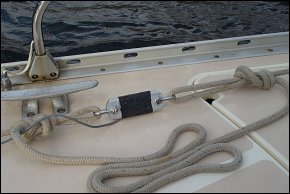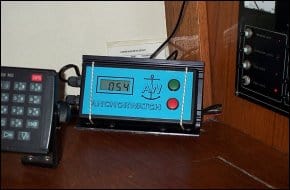Westbound Adventurer was tugging gently at anchor in East Loch Roag within sight of the Callanish Standing Stones. I was enjoying a few hours of solitude between two “6 day teaching cruises”. The crew of the previous week had helped me bring Westbound Adventurer from my summer base on Barra and I had just returned from taking leave of them in Stornoway, complete with fresh provisions for the next cruise. In a few hours time I would be back on the bus to meet the most cosmopolitan crew yet.
As the Saturday evening Calmac ferry berthed in Stornoway I had a minibus standing by to whisk them 20 miles by road to Callanish. We could have waited 3 hours to get the local 16-seater bus but the driver could not give me a guarantee that there would be room for my 5 crew with all their gear. The prospect of being stranded in Stornoway until Monday morning was unacceptable in view of the distance my crew were travelling to start their Westbound Adventures.
Jim was arriving from Aberdeen, Malcolm from Yorkshire, Andreas from Switzerland, Boris and Elena were Polish and Russian living as a couple in London. Malcolm was the only one who had sailed with me before so it was a case of sniffing out 4 yotties from the crowd disembarking from MV Isle of Lewis which had arrived on time as if fearful of breaking the Sabbath. We brushed past the Callanish Stones at dusk allowing the driver time to return to Stornoway before the midnight hour. I was keen to complete the multiple shuffle by dinghy before it got too dark and promised the crew there would be time for a morning visit to the Stones.
Dawn, breakfast, safety brief and item 10 on the Comp Crew syllabus for Boris and Elena as they rowed the dinghy to the Stones and back for those who wanted to make a short visit. The rest of the morning was spent sailing up East Loch Roag and getting familiar with the yacht. As we enjoyed an idyllic lunchtime anchorage in Bernera Harbour I had some difficulty explaining why we should postpone any Atlantic Adventures for at least 24 hours. I decided that the best illustration would be to take the outer route into West Loch Roag so that they could experience a leftover Atlantic swell for about an hour before reaching the shelter of the West Loch. Twenty minutes into the swell and everyone was singing in unison about the delights of inner sea loch exploration and that is exactly what we did.We took on water in the upper reaches of Loch Miavaig then made our way back down to the Valtos sands for our second night at anchor in this lost paradise of sheltered sea lochs which could easily occupy 2 weeks of exploration.
As we cleared Gallan Head next morning we discovered that the Atlantic swell had died down and the forecast light NE wind had not yet arrived. As soon as Boris and Elena had proved that they could steer a compass course Alfred the Autohelm was ordered on deck to take us to the Flannan Isles. Andreas was an experienced yottie but had done little sailing in tidal waters. He did a good job calculating a course to steer across the tide, which runs up and down the western edge of the Outer Hebrides. The 3 hour passage under power had the 2 comp crew in knots, Jim and Andreas doing navigation exercises, and Malcolm guessing the distance to run to the Flannan Isles from the comfort of an inverted dinghy on the foredeck. There is nothing in the RYA syllabus that forbids a comfortable passage! Our arrival at the Flannan Isles on a perfect summer day is best described in the photo sequence. (Click any picture to enlarge).
I made a quick visit ashore and was rewarded with breathtaking views of the hills of Lewis and Harris to the east and 40 miles to the southwest I could make out the distinctive shape of Boreray and Hirta that was to be our next destination. (For technical details of our line ashore and anchorage by angel see the appendix.) All visits ashore were completed by mid-afternoon but the NE wind had not yet arrived so we decided to rest up until late evening in the hope of an overnight sail to St.Kilda.
We departed the Flannan Isles under sail at 2040 on 6 August and dropped anchor under sail in Village Bay, St.Kilda at 0630 the next morning. It was not a fast passage but it was a very satisfying and comfortable one with a light NE wind dead astern. We split the night hours into comfortable 2 hour watches and just before I went below I remembered I had made a promise to my daughter. The handwritten message, which had been carefully laminated by Mum, was still in my possession. Dad had promised to seal it in a bottle and deploy it somewhere west of the Hebrides. I thought I had better get a photo as documentary evidence! I have been to St.Kilda many times but this was the first occasion I have sailed past Borerary and its stacks in the pre dawn. All the crew were roused from their slumbers for this dramatic moment. My cosmopolitan crew were stunned into silence as we ghosted past Boreray. It is the only occasion I have sailed past Stac Lee and not been deafened by the chorus of seagulls. When we cleared Stac Lee we were treated to the distant sight of dawn breaking over the Outer Hebrides some 45 miles to the east.
One hour after we dropped anchor in Village Bay the magic of the place was dispelled. An army of construction workers in hard yellow hats appeared. A cement mixer was started. A dumper truck complete with flashing amber light drove here, there and everywhere. My cosmopolitan crew had to go ashore. They had completed a 2-page questionnaire issued by the National Trust for Scotland to grant them clearance to land due to the restrictions imposed by the foot and mouth crisis. I had done everything by the letter of the law and spent many hours getting all the paperwork to them and back to NTS for this and the previous week’s crew who had also made it to St.Kilda. There were other yacht crew arriving without paperwork clearance but the NTS warden was processing them at the drop of a hat. My blood started to boil and I did not go ashore, as I would have said something I might have regretted later!
At 1145 on 7 August we cleared out of Village Bay. The crew’s short visit ashore had been restricted to the village itself. The NE wind had been rising all morning and a swell was setting into the bay. We set off on a cracking reach towards the Sound of Barra with Alfred confined to his locker as we enjoyed one hour each on the helm. The wind died down in the early evening but remained in the NE and we were able to maintain good boat speed under sail. I knew we were unlikely to clear the Sound of Barra before dark and I had considered anchoring off Orosay on South Uist until dawn. In an offshore wind I would recommend this to most yachtsmen as a night passage of the Sound of Barra should not be undertaken without intimate local knowledge. (See appendix for technical details) I did the blind navigation of the Sound of Barra under power and the crew spotted a bright green flashing light which had been put down a few days earlier. I wonder how long it will take for the chart corrections to be published? At 2345 we dropped anchor in Acairseid Mor, Eriskay. A very successful 12 hour passage with 64 miles on the log. The average speed under sail from St.Kilda to the west end of the Sound of Barra was 6 knots with the blind passage through the Sound at a much slower speed.
The following morning the crew explored the Island of Eriskay on foot and I visited one of my cousins who was Boatmaster of the ferry from South Uist to Eriskay until the very recent completion of the causeway. Opinion on the island is very divided on the issue of the causeway. I had a number of questions to put to him regarding local pilotage information. (See appendix for details.) We departed Eriskay late afternoon for a short sail to the best anchorage on Barra, which of course, is Northbay.
On 9thAugust we enjoyed a good sail down the east side of Barra and a passage round Mingulay taking a close look at the spectacular sea cliffs on the west side of Mingulay, the second highest sea cliffs in Britain. The highest sea cliffs are those of St.Kilda which we had visited only �was it hours or days ago? Later that afternoon we tacked our way into Vatersay Bay and completed a number of nautical manouvres required by the RYA syllabus. As we lay at anchor in one of my favourite places my cosmopolitan crew had to photograph the cows on the beach. It is something I have always taken for granted since family holidays as a child. Another peaceful night at anchor blest with a glorious Hebridean sunset. The only yacht in a beautiful bay with silver sands and clean, clear waters.
The following morning the sun danced and the water sparkled. We didn’t notice the gentle giant approach from the east because we were busy getting the anchor up. It approached very slowly, all 60 feet if it. Its bow was almost on top of us when 2 uniformed crew hailed us. One of them had a notebook and pen in his hand. “Just one or two questions, Sir” I pointed out that as an RYA Recognised Sailing School the answers to all his questions were contained in the RYA website and in the Coastguard CG66 to which HM Customs had instant access. “Yes sir, but it would make my job a little easier if you would just tell me your destination.” I pointed to the north and shouted “Castlebay, it’s where these people need to get tonight’s ferry to get to Oban then Aberdeen, Yorkshire, London and Switzerland!” “What is your name sir?” “McNeill” “Oh you are one of them?” HM Customs made a swift departure.
Yes, my crew had come a long way for their Westbound Adventures but as I took my leave of them on Castlebay pier later that evening they assured me they would return to the Outer Hebrides and they will.



